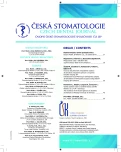Dental Caries Prevention Strategies, Application of Evidence-Based Medicine
Part I. Basic Documents, Global and European Initiatives
Authors:
Z. Broukal 1; J. Dušková 1; V. Merglová 2; R. Koberová-Ivančaková 3; E. Ryšlavá 4
Authors‘ workplace:
Stomatologická klinika 1. LF UK a VFN, Praha
1; Stomatologická klinika, LF UK a FN, Plzeň
2; Stomatologická klinika, LF UK a FN, Hradec Králové
3; Colgate-Palmolive Česká republika spol. s r. o., Praha
4
Published in:
Česká stomatologie / Praktické zubní lékařství, ročník 115, 2015, 2, s. 19-25
Category:
Review Article
Overview
Background and aim:
Summarizing series of overview articles intends to show current strategy to prevent tooth decay and contemporary transnational initiatives aimed mainly at controlling caries in children and youth. In the first part of this series is defined the problem of dental caries in its social and public health context, taking account of new diagnostic technologies and decision-making processes about his healing or restoration. It is emphasized here the application of the concept of evidence based medicine evaluating the results published in information resources in terms of their scientific quality and weight recommendations for clinical practice and their projections into the current dental literature. The aim of this review is to characterize the basic current trends in dental caries prevention and their implementation of into individual and community preventive practice.
Keywords:
dental caries prevention strategies – evidence-based medicine
Sources
1. ACFF – The Aliance for a Cavity-Free Future, 2010, dostupné na www.AllianceForACavityFreeFuture.org
2. Bretz, W. A., Rosa, O. P.: Emerging technologies for the prevention of dental caries. Are current methods of prevention sufficient for the high risk patient? Int. Dent. J., roč. 61, 2011, Suppl. 1, s. 29-33. doi: 10.1111/j.1875-595X.2011.00027.x.
3. Featherstone, J. D. B.: Prevention and reversal of dental caries: role of low level fluoride. Community Dent. Oral Epidemiol., roč. 27, 1999, č. 1, s. 31–40.
4. Grade Working Group: Atkins, D., Best, D., Briss, P. A., Eccles, M., Falck-Ytter, Y., Flottorp, S., et al.: Grading quality of evidence and strength of recommendations. BMJ, roč. 328, 2004, č. 19, s. 1490–1494.
5. Kim Seow, W.: Environmental, maternal, and child factors which contribute to early childhood caries: a unifying conceptual model. Int. J. Paediatr. Dent., roč. 22, 2012, č. 3, s. 157–168. doi: 10.1111/j.1365-263X.2011.01186.x.
6. Patel, R.: European Platform for Better Oral Health in Europe, 2012, dostupné na http://www.oralhealthplatform.eu/
7. Petersen, P. E.: The World Oral Health Report 2003; Continuous improvement of oral health in the 21st century - the approach of the WHO Global Oral Health Programme. Community Dent. Oral Epidemiol., roč. 31, 2003, Suppl. 1, s. 3–23.
8. Petersen, P. E., Bourgeois, D., Ogawa, H., Estupinan-Day, S., Ndaye, C.: The global burden of oral diseases and risks to oral health. Bull. World Health Organ., roč. 83, 2005, č. 9, s. 661–669.
9. Pretty, I. A., Ellwood, R. P.: The caries continuum: opportunities to detect, treat and monitor the re-mineralization of early caries lesions. J. Dent., roč. 41, 2013, Suppl. 2, s. S12–21.
10. Richards, D., Lawrence, A.: Evidence based dentistry. Brit. Dent. J., roč. 179, 1995, č. 7, s. 270–273.
11. Ritter, A. V., Shugars, D. A., Bader, J. D.: Root caries risk indicators: a systematic review of risk models. Community Dent. Oral Epidemiol., roč. 38, 2010, č. 5, s. 383–397.
12. Rohr Inglehart, M., Bagramian, R. A.: Oral health-related quality of life. Chicago: Quintessence, 2002.
13. Sackett, D. L., Rosenberg, W. M. C., Gray, J. A. M., Hayes, R. B., Richadson, W. S.: Evidence based medicine: what it is and what it isn‘t. BMJ, roč. 312, 1996, č. 7023, s. 71–72.
14. Shekelle, P. G., Woolf, S. H., Eccles, M., Grimshaw, J.: Clinical guidelines: developing guidelines. BMJ, roč. 318, 1999, č. 7183, s. 593–596.
15. U.S. Department of Health and Human Services: Oral Health in America: A Report of the Surgeon General. Rockville, MD: U.S. Department of Health and Human Services, National Institute of Dental and Craniofacial Research, National Institute of Health, 2000, dostupné na http://silk.nih.gov/public/hck1ocv.@www.surgeon.fullrpt.pdf.
16. World Health Organization: Global strategy for health for all by the year 2000, Geneva, World Health Organization, 1981, ISBN 92 4 180003 8.
17. World Health Organization. Health21 – Health for All in the 21st Century. Series No. 5, Copenhagen: WHO Regional Office for Europe, 1998, ISBN 92 890 1348 6.
18. World Health Organization: Fluorides and Oral Health. WHO Technical Report Series No. 846. Geneva, World Health Organization, 1994.
19. World Health Organization: Diet, Nutrition and the Prevention of Chronic Diseases. WHO Technical Report Series 916. Geneva: World Health Organization, 2003.
Labels
Maxillofacial surgery Orthodontics Dental medicineArticle was published in
Czech Dental Journal

2015 Issue 2
Most read in this issue
- Supernumerary Teeth in the Childhood
-
Introduction to 3D Planning in Orthognatic Surgery.
3D Simulation of Orthognatic Surgery Using Dolphin Imaging 3D® Software -
Dental Caries Prevention Strategies, Application of Evidence-Based Medicine
Part I. Basic Documents, Global and European Initiatives - The Incidence of the Tooth Agenesis in Students of Dentistry at Palacký University in Olomouc
